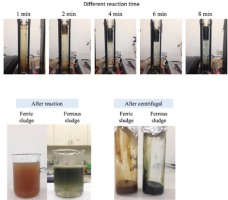Journal of the Taiwan Institute of Chemical Engineers ( IF 5.7 ) Pub Date : 2017-12-24 , DOI: 10.1016/j.jtice.2017.12.004 Vinh Ya , Natacha Martin , Yi-Hsuan Chou , Yi-Ming Chen , Kwang-Ho Choo , Shiao-Shing Chen , Chi-Wang Li

|
Surface finishing wastewater having low pH (∼2) and high conductivity (>11 mS/cm) was treated by electrocoagulation (EC) or electrochemical Fenton (ECF) processes using sacrificial iron anodes. Under the same theoretical Fe dosage, the effects of electrolytic time, initial pH, and current density on the simultaneous removal of organic and heavy metal were investigated. A complete metal removal was achieved even at the low current density of 24.2 mA/cm2 and short electrolytic time of 4 min, whereas approximately 40% of chemical oxygen demand was removed. Increasing the electric current density did not improve removal efficiencies, but consumed more electric energy. Low current conditions produced a brown color sludge associated with ferric hydroxide. On the contrary, a greenish color sludge was created at a high current due to the formation of ferrous hydroxide. The formation of ferrous hydroxide impacted the treated water quality. The ECF was employed to overcome the low COD removal by the EC, achieving >67% of COD removal. The costs of ECF processes were slightly greater than that of chemical coagulation, but achieving a lot greater heavy metal removals. ECF process can be a promising method for simultaneous removal of heavy metal and organics from complex industrial wastewater.
中文翻译:

电化学处理,使用牺牲铁阳极同时去除表面处理废水中的重金属和有机物
使用牺牲性铁阳极通过电凝(EC)或电化学Fenton(ECF)工艺处理低pH(〜2)和高电导率(> 11 mS / cm)的表面处理废水。在相同的理论Fe用量下,研究了电解时间,初始pH和电流密度对同时去除有机物和重金属的影响。即使在24.2 mA / cm 2的低电流密度下也可以完全去除金属电解时间短至4分钟,而化学需氧量却减少了约40%。增加电流密度并没有提高去除效率,但是消耗了更多的电能。低电流条件产生与氢氧化铁有关的棕色淤渣。相反,由于氢氧化亚铁的形成,在高电流下会产生绿色的淤泥。氢氧化亚铁的形成影响了处理后的水质。ECF被用来克服EC去除低COD的问题,实现了> 67%的COD去除率。ECF工艺的成本比化学混凝的成本稍高,但是去除重金属的成本要高得多。ECF工艺可能是一种从复杂工业废水中同时去除重金属和有机物的有前途的方法。



























 京公网安备 11010802027423号
京公网安备 11010802027423号